Eco-friendly Innovation
綠色創新
Recovering and Reusing Rainwater and Grey Water in Buildings
Due to extreme weather patterns and water shortage, it is now a global trend to collect and store rainwater and sewage (such as water from bath, hand-washing and dish-washing) as grey water for reuse. The technologies behind them are not complex, and by doing so we can reduce the cost incurred from delivering tap water over a long range distance as well as the maintenance cost. It relieves the government’s stress to develop large scale water resource projects, and can be a way to develop the so-called “Spongy Resilient City.” In this article, we will take CTCI’s 2nd headquarters building as an example and talk about how CTCI team encourages recycling and reuse of water through rainwater and grey water collection design.
Introduction to Rainwater Collection and Storage System
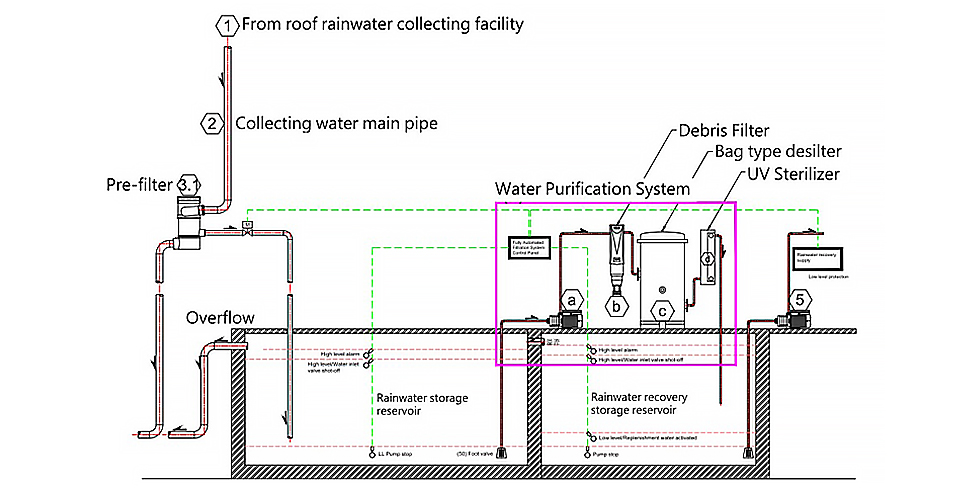
Diagrammatic Sketch of Rainwater Recovery
Rain can be collected through gutters and catchment pipes on building roofs and awning. It can also be collected through nature terrain and surface runoff. The collected water is then precipitated and filtered, so that it can be used for toilet flushing, plant irrigation and floor washing. During water shortage and ration periods, this approach can help reduce the demand on city water and can extend the waiting period for city water supply recovery. There are primarily two applications from collected rainwater: 1.The rainwater is collected and stored in the rainwater tanks for miscellaneous water use. 2.The collected rainwater serves as replenishment to groundwater, to avoid groundwater shortage. A rainwater storage and reuse system is comprised of five main facilities, which are collection facility, transportation facility, purification facility, storage facility, and pumping facility. The first main component of the rainwater collection system is the pre-filter, which helps separate the debris (particles, clastic stones, defoliation, etc.) in the rainwater confluence from the roof as tentative clean water, so that the rainwater can further converge and flow towards the storage pools. In general, the preferred pre-filter is one that can clean by itself and can run without the need for external power and accessories. Currently, there are two types of pre-filters that require no additional power, have low dredging requirements, and come with anti-rainstorm direct overflow device. 1.Type 1: Rainwater flows through the collection main pipe through the 45° inclined cut-off filter mesh. Rainwater is not only directly intercepted, but helps flush the twig and leaves on the filter mesh by gravity down to the drain. Under the filter mesh is the rainwater collecting point. Type 2: Rainwater from high point flows down to the rainwater recover filter. Due to the internal structural design of the filter tank, rainwater would enter the pre-filter from sideways and flow through the filter mesh in the form of centrifugal vortex turbulence, helping separate the debris along the way. Rainwater would flow to the collecting point, while the filtered debris would drop to the draining point. This type of pre-filter was applied by CTCI 2nd HQ due to the advantage of low noise and low flow impact.
Rainwater Recovery System
To reuse water and make good use of sustainable resources, the CTCI 2nd headquarters building has incorporated the rainwater recovery system into building design. The building’s rainwater recovery system uses gutters and rainwater collecting pipes on the roof to collect substantial amount of rainwater. High cage sink drains are installed to intercept larger leaves and debris. With centrifugal force, the rainwater is collected and flows through the pre-filter vertical mesh wall to completely separate large debris. This is gravity filtration without power and supplies. Afterwards, the rainwater enters temporary reservoir, then pre-filtered and sterilized with ultraviolet light. In the end, it flows to rainwater regeneration pond for plant and landscape irrigation. The rainwater filtering system will be activated to replenish the rainwater regeneration pond if the water level is low. In the case where both recovery pool and regeneration pond are both at low level, city water replenishment will be activated.
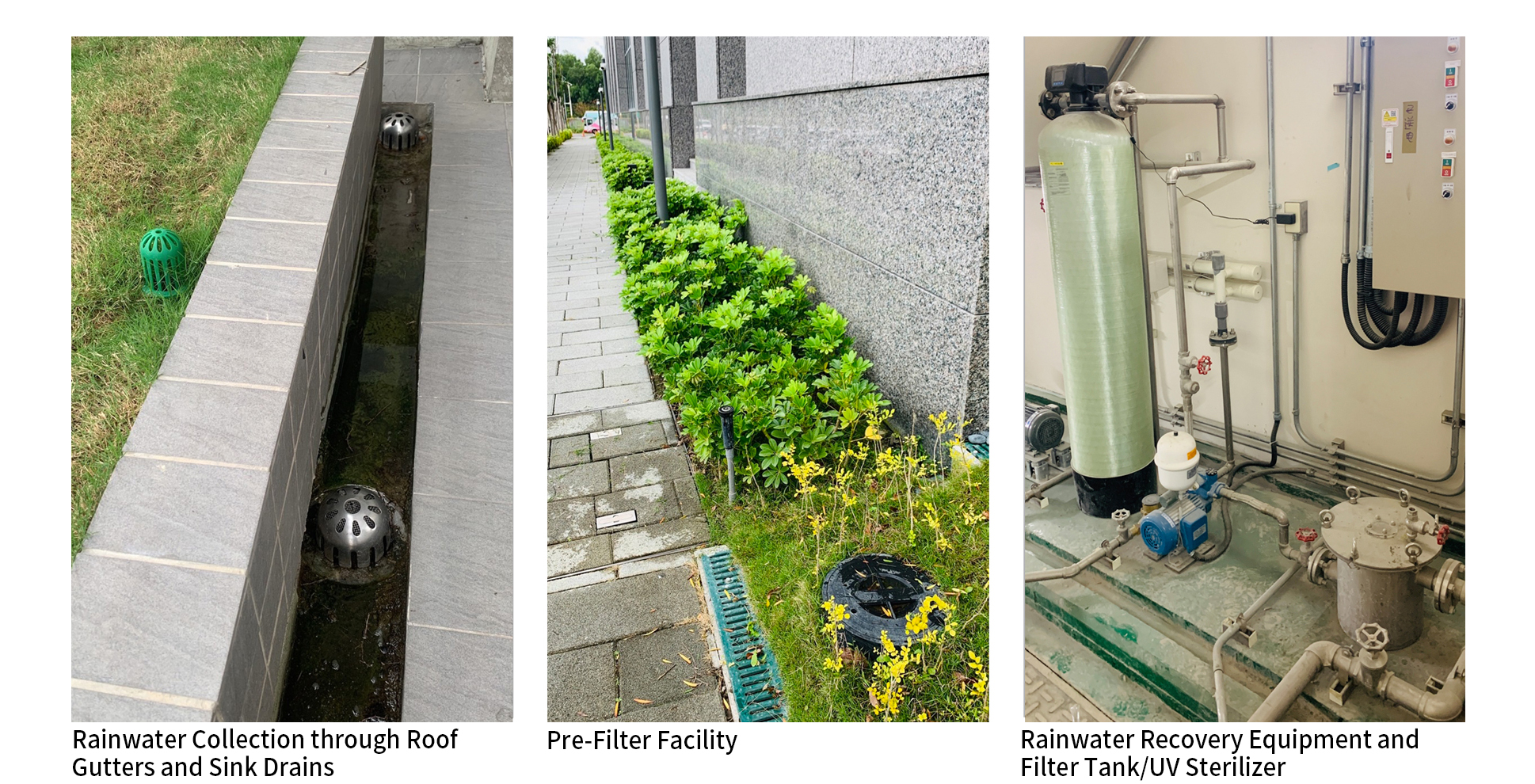
Rainwater Recovery Photos of CTCI 2ND HQ
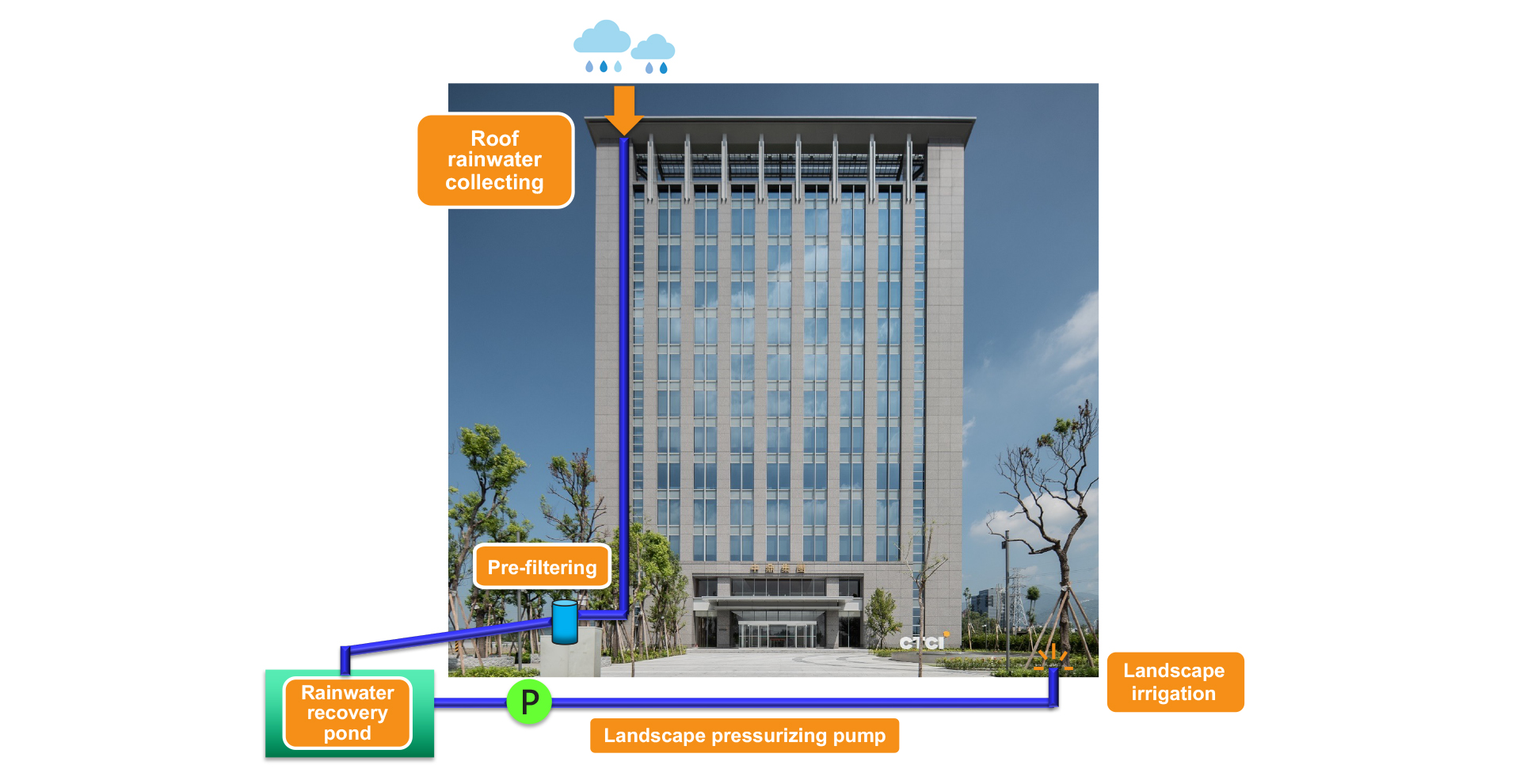
Diagrammatic Sketch Showing How Rainwater Is Recovered at CTCI 2nd HQ
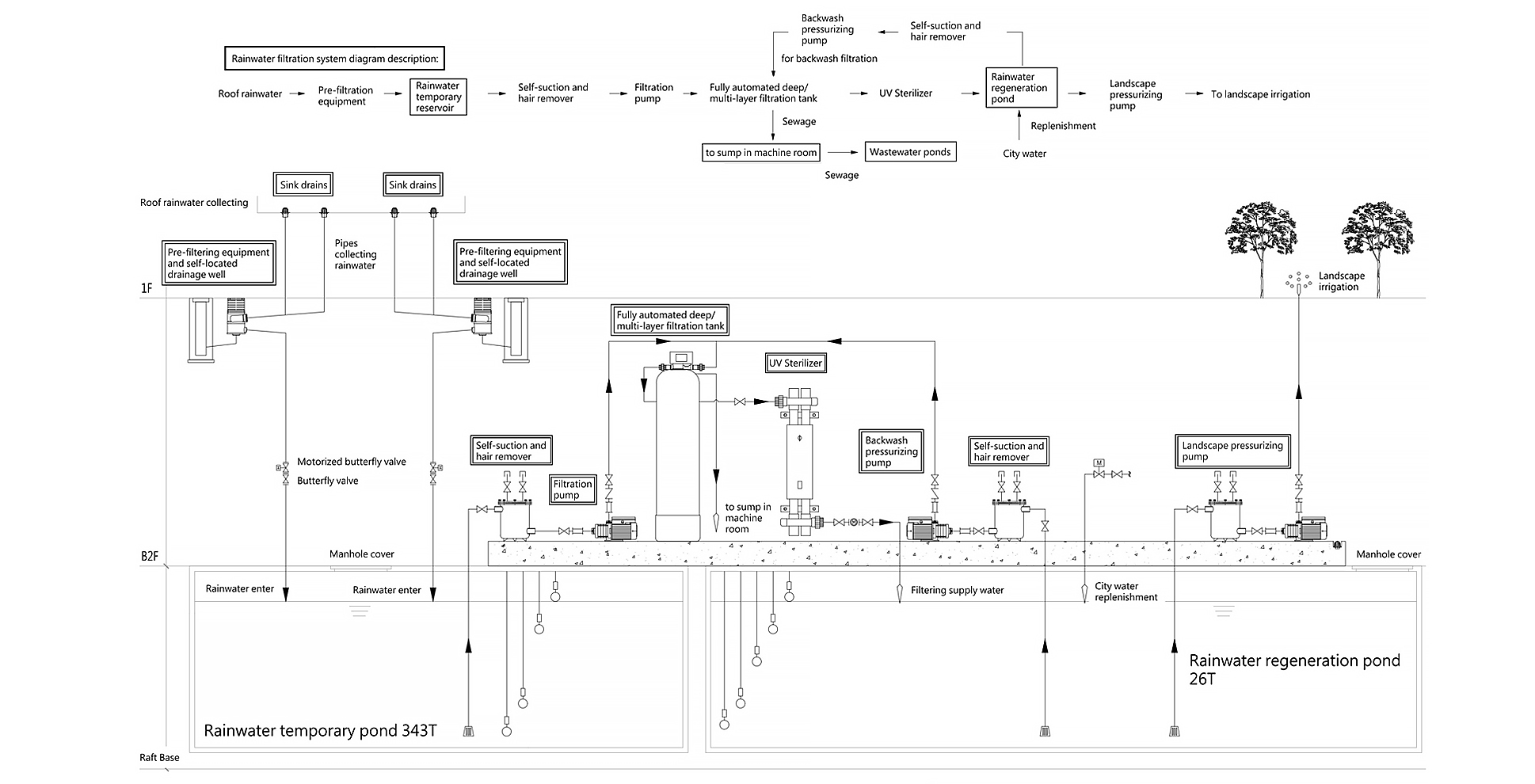
Rainwater Recovery System Diagram of CTCI 2nd HQ
Planning for Grey Water Recovery and Reuse
Grey water, also known as reclaimed water or recycled water, is unpotable and usually reserved for “non-contact” water uses (non-contact with human body), such as toilet flushing, car washing, and plant irrigation. During the design stage for CTCI 2nd headquarters building, CTCI team incorporated the 3R concept (reduce, reuse, recycle) into building design. Apart from selecting sanitation facilities that have water saving labels, the building’s water supply control valve is adjusted to reduce the water flow based on the recommended standards by the Water Resource Agency. Recovered grey water is used to flushing toilet and urinals, as well as hand washing. This maximizes the uses of water resources. The following is a design of grey water recovery for toilet sinks: independent pipe from sink → grey water temporary reservoir → grey water filtering equipment → grey water regeneration pond →grey water tank on the roof. After that, the grey water is supplied through independent pipes for toilet and urinal flushing. City water will be supplemented if in short of recovered water.
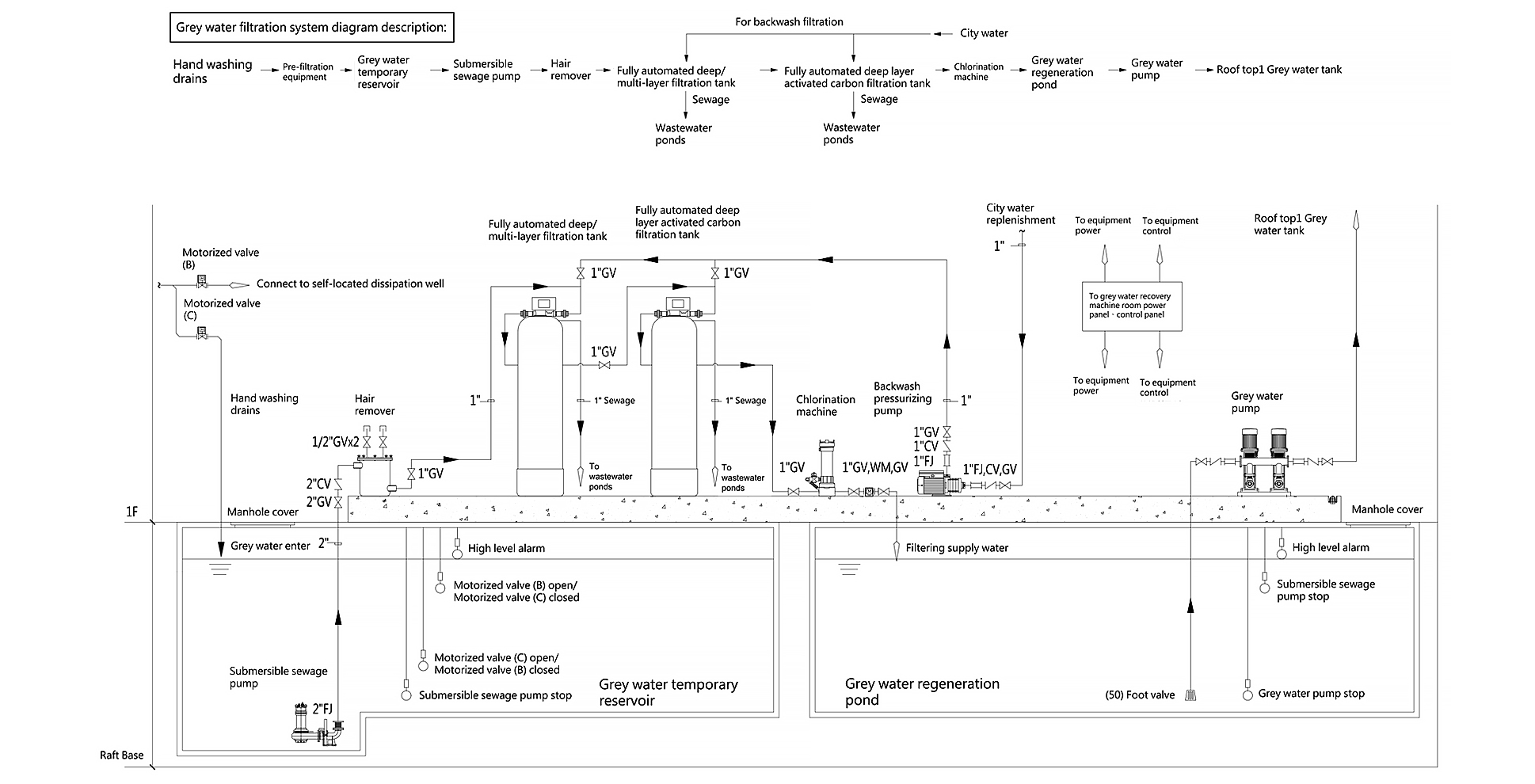
Diagram of CTCI 2nd HQ’s Grey Water Recovery System
By applying these technologies, CTCI Group successfully created a rainwater and grey water recovery systems for the 2nd headquarters. By recycling and reusing water, CTCI maximized the values of resource, and made a humble contribution towards global sustainability.


